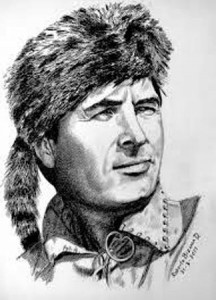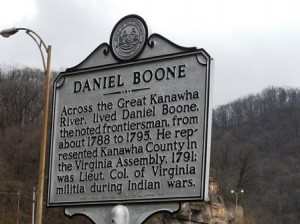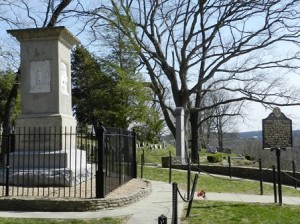» posted on Tuesday, April 2nd, 2013 by Linda Lou Burton
Bewildered, But Never Lost
 Linda Burton posting from Frankfort, Kentucky – “I can’t say as ever I was lost, but I was bewildered once for three days.” That line, like so many tales, is attributed to Daniel Boone (1734-1820), whose exact whereabouts and final resting place are not completely substantiated, but heck, you want to believe all the stories you hear, they are so entertaining. Was he a hunter? That part is likely true. Did he live in Pennsylvania, North Carolina, Virginia, Tennessee, Kentucky, Missouri? West Virginia claims Daniel; in Charleston I visited Daniel Boone Park on the banks of the Kanawha River, and photographed his (alleged) rifle, walking cane, and a
Linda Burton posting from Frankfort, Kentucky – “I can’t say as ever I was lost, but I was bewildered once for three days.” That line, like so many tales, is attributed to Daniel Boone (1734-1820), whose exact whereabouts and final resting place are not completely substantiated, but heck, you want to believe all the stories you hear, they are so entertaining. Was he a hunter? That part is likely true. Did he live in Pennsylvania, North Carolina, Virginia, Tennessee, Kentucky, Missouri? West Virginia claims Daniel; in Charleston I visited Daniel Boone Park on the banks of the Kanawha River, and photographed his (alleged) rifle, walking cane, and a  rock with his name inscribed, all displayed behind glass at the Cultural Center. I drove through Daniel Boone National Forest today, and passed a sign to Boonesborough, just south. Tonight I sleep in Frankfort, Kentucky, one of the places that claims his grave. Did Daniel Boone “kill bar” as is carved in a tree in Tennessee? Did Daniel Boone wear a coonskin cap? He probably killed bear; boys in the 1700’s typically learned to use a rifle at an early age. His father is reputed to have said, regarding Daniel’s
rock with his name inscribed, all displayed behind glass at the Cultural Center. I drove through Daniel Boone National Forest today, and passed a sign to Boonesborough, just south. Tonight I sleep in Frankfort, Kentucky, one of the places that claims his grave. Did Daniel Boone “kill bar” as is carved in a tree in Tennessee? Did Daniel Boone wear a coonskin cap? He probably killed bear; boys in the 1700’s typically learned to use a rifle at an early age. His father is reputed to have said, regarding Daniel’s  education “Let the girls do the spelling and Dan will do the hunting.” Daniel was literate, he (allegedly) toted the Bible and Gulliver’s Travels on trips and would read to his traveling companions around the evening campfire. As to that coonskin cap; it is fairly well documented that Daniel was about 5’7” in stature; the image of the tall hunter in the coonskin cap is more likely due to the role played by Fess Parker in the Daniel Boone TV series of the ‘60’s. Fess was a tall man, and wore a coonskin cap in his earlier “frontier man” Davy Crockett role. That is how images are created, you see. Like the Leatherstocking Tales.
education “Let the girls do the spelling and Dan will do the hunting.” Daniel was literate, he (allegedly) toted the Bible and Gulliver’s Travels on trips and would read to his traveling companions around the evening campfire. As to that coonskin cap; it is fairly well documented that Daniel was about 5’7” in stature; the image of the tall hunter in the coonskin cap is more likely due to the role played by Fess Parker in the Daniel Boone TV series of the ‘60’s. Fess was a tall man, and wore a coonskin cap in his earlier “frontier man” Davy Crockett role. That is how images are created, you see. Like the Leatherstocking Tales.
James Fenimore Cooper published the first of the Leatherstocking Tales in 1823; the main character, Nathaniel Bumppo, was strikingly similar to Daniel Boone. The Last of the Mohicans, published in 1826, was a fictionalized account of Daniel’s 1776 rescue of his daughter Jemima, who had been captured by Indians along with two other girls. Other writers took the cue, shaping heroic images to suit popular tastes. And so it goes. Horn in the West has been performed in Boone, North Carolina every year since 1957, a fictional account of the lives of settlers that Daniel Boone led into the Appalachian Mountains. In addition to being a “heroic figure,” Daniel was often portrayed as a lone “wilderness man;” consider these stanzas from Lord Byron’s poem Don Juan (1822):
Of the great names which in our faces stare, The General Boon, back-woodsman of Kentucky, Was happiest amongst mortals any where; For killing nothing but a bear or buck, he Enjoyed the lonely vigorous, harmless days Of his old age in wilds of deepest maze.
 Alone in the wilds? Not exactly. Daniel was born into a Quaker family in Pennsylvania, the sixth of eleven children. He and his wife Rebecca had ten children. He was a member of the militia in the French and Indian War, the Revolutionary War, and the War of 1812. He fought against Indians and lived with Indians. He hunted and sold furs for a living; he served as a delegate in the General Assembly of Virginia. He blazed trails through the wilderness and lived quietly by the side of Femme Osage Creek with his family. He died of natural causes in 1820 at age 85, and was buried next to his wife Rebecca, near daughter Jemima’s home on Tuque Creek, about two miles from present-day Marthasville, Missouri. His remains were moved, in 1845, to
Alone in the wilds? Not exactly. Daniel was born into a Quaker family in Pennsylvania, the sixth of eleven children. He and his wife Rebecca had ten children. He was a member of the militia in the French and Indian War, the Revolutionary War, and the War of 1812. He fought against Indians and lived with Indians. He hunted and sold furs for a living; he served as a delegate in the General Assembly of Virginia. He blazed trails through the wilderness and lived quietly by the side of Femme Osage Creek with his family. He died of natural causes in 1820 at age 85, and was buried next to his wife Rebecca, near daughter Jemima’s home on Tuque Creek, about two miles from present-day Marthasville, Missouri. His remains were moved, in 1845, to  Frankfort Cemetery in Kentucky. Resentful Missourians claim the wrong body was moved; today both cemeteries purport to be Daniel’s Final Resting Place. A forensic anthropologist who examined a crude plaster cast of Daniel’s skull, made before the Kentucky reburial, announced it “might be” the skull of an African American. Slaves were buried at Tuque Creek, so, the mystery remains.
Frankfort Cemetery in Kentucky. Resentful Missourians claim the wrong body was moved; today both cemeteries purport to be Daniel’s Final Resting Place. A forensic anthropologist who examined a crude plaster cast of Daniel’s skull, made before the Kentucky reburial, announced it “might be” the skull of an African American. Slaves were buried at Tuque Creek, so, the mystery remains.
The truth is simple enough: the name Daniel Boone stirs people to action, or at the least, to dream. What IS over that next hill? Can I face the unknown and make a go of life, no matter what the obstacles? Boonesborough was one of the first American settlements west of the  Appalachians; by the end of the 18th century, more than 200,000 Europeans migrated west following the trail marked by Daniel Boone. We know he was a son, husband, father and grandfather; history and legend tell us he was a backwoodsman, delegate, explorer, hunter, land speculator, lieutenant, marksman, merchant, sheriff, soldier, surveyor, trading post operator, trailblazer, trapper, Spanish syndic and commandant, Virginia assemblyman; and, an American idol.
Appalachians; by the end of the 18th century, more than 200,000 Europeans migrated west following the trail marked by Daniel Boone. We know he was a son, husband, father and grandfather; history and legend tell us he was a backwoodsman, delegate, explorer, hunter, land speculator, lieutenant, marksman, merchant, sheriff, soldier, surveyor, trading post operator, trailblazer, trapper, Spanish syndic and commandant, Virginia assemblyman; and, an American idol.
In 1816, a United States officer at Fort Osage on the Missouri, wrote, We have been honored by a visit from Colonel Boon, the first settler of Kentucky; he lately spent two weeks with us….He left this for the river Platt, some distance above. Col Boon is eighty-five years of age, five feet seven inches high, stoutly made, and active for one of his years; is still of vigorous mind, and is pretty well informed. He has taken part in all the wars of America, from before Braddock’s war to the present hour.
One last quote attributed to Daniel. Many heroic actions and chivalrous adventures are related of me which exist only in the regions of fancy. With me the world has taken great liberties, and yet I have been but a common man.
Never lost, but bewildered once, for three days.
